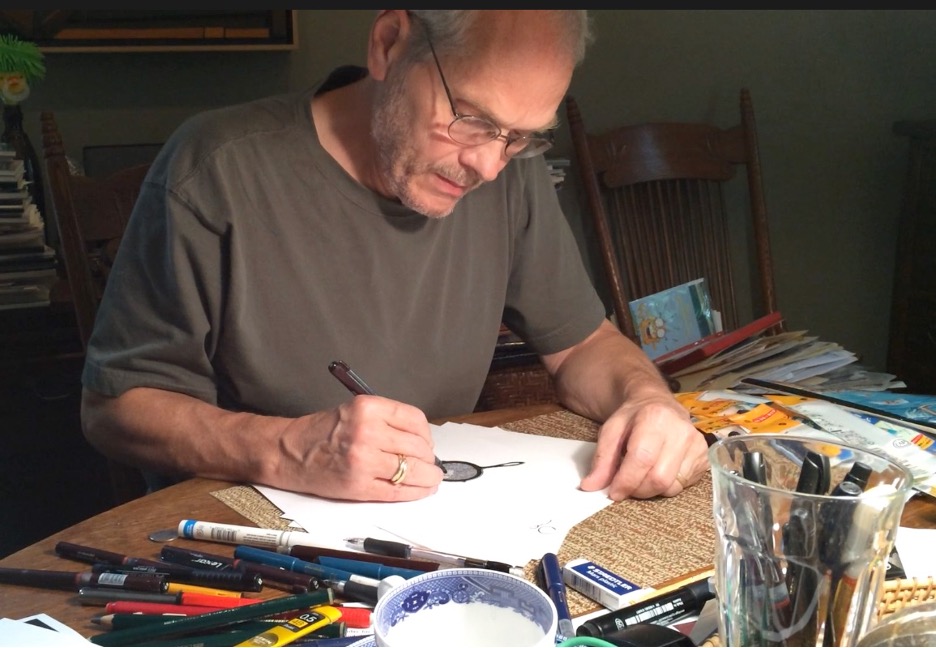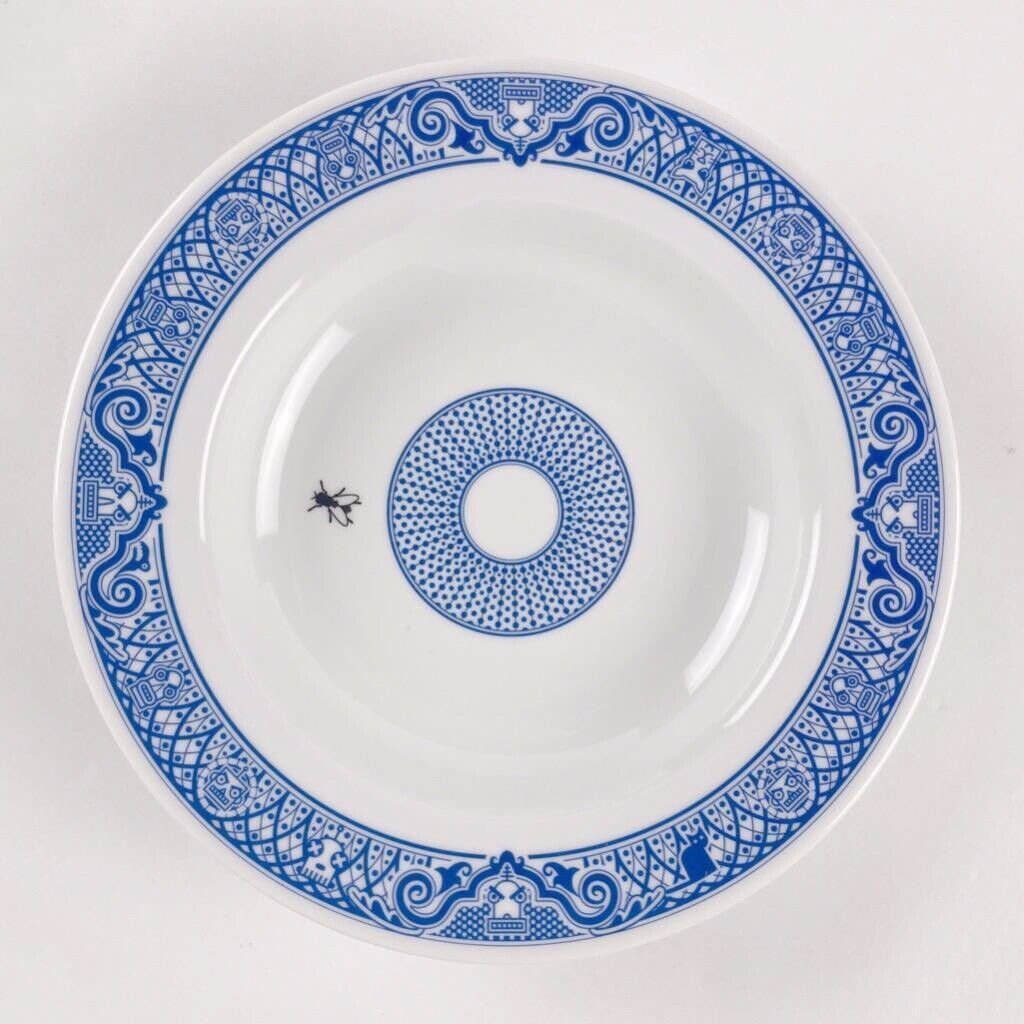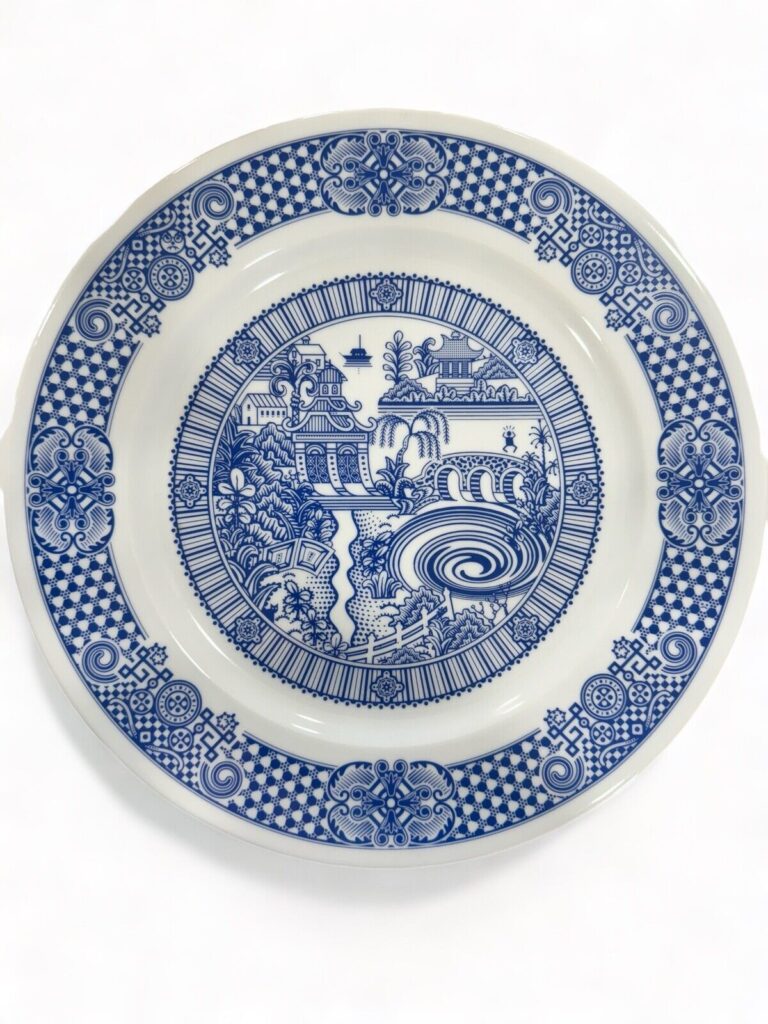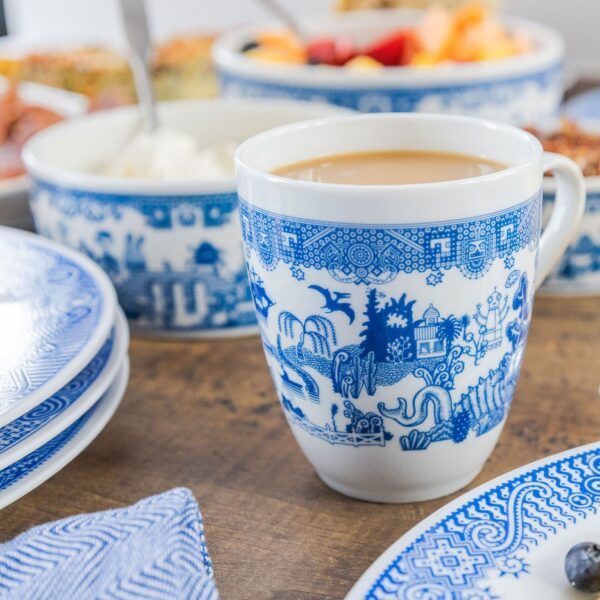#Calamityware #Chaos #China #Cabinet #WorthPoint

Photo courtesy: Calamityware
The next time you admire a piece of transferware china, look closely at the intricate landscape scenes and skies filled with . . . wait—those aren’t birds—they’re prehistoric Pterodactyls. No, friend, you don’t need glasses. You have discovered Calamityware, a modern dining collection adding a wickedly humorous twist to a centuries-old dishware pattern. With a product tagline of “Things Could Be Worse,” what did you expect?
What Is Transferware?
Before we can appreciate the Calamityware phenomena, we should briefly review the story of transferware. This elegantly intricate china pattern began appearing in British homes in the late 1700s around Staffordshire, England. Because manufacturers hand-painted each of these early ceramic pieces, they were only available to the wealthy. Transfer printing, however, allowed the mass production of affordable pieces for ordinary households.
The transferware process begins with an inked copper plate used to emboss the pattern onto thin paper, which is then moistened and placed onto a blank piece of dishware, thus transferring the image. After that, the piece is fired twice in a kiln to set the pattern and bake the applied glaze for a glossy finish.
Early transferware manufacturers include Royal Staffordshire, Johnson Brothers, Spode, and Enoch Wood. As this dishware became popular in the United States, the images depicted farm scenes, events like the Lewis & Clark expedition, and famous buildings. Blue and white pieces were the most popular available colors, but manufacturers also produced items in red, pink, brown, gray, and mulberry. Blue Willow china, often referred to as “the South’s favorite dinnerware,” also features blue (and even multicolored) nature and Asian-inspired images on white porcelain.
Antique China in Need of a Parody
I recently caught up with Don Moyer—the artist behind Calamityware—for a brief email interview. I learned the entire collection stemmed from a Blue Willow plate he inherited from his grandmother. The retired graphic designer from Pittsburgh, Pennsylvania, said he was intrigued by the piece’s intricately sketched patterns of serene landscapes, flora, and fauna. So, he sketched the dish with its existing designs and replaced the birds with characters like a Pterodactyl, flying monkeys, and alien spaceships. “That’s the kind of thing I find amusing,” he said. “When I draw, my goal is to make myself laugh. So, naturally, I often draw cats, monkeys, gargoyles, aliens, and similar nonsense. To me these subjects are comedy gold.”
Moyer added that a product line as old as transferware was ripe for parody. “Plop a silly monkey playing cymbals into a tranquil Asian landscape, and I’m smiling at the juxtaposition,” he said.
After posting the image on Flickr, followers suggested he turn the design into an actual ceramic plate. Moyer launched his first Calamityware plate in 2013 on crowdsourcing platform Kickstarter and received enough funding for a first production run. The plate design featured a squadron of flying monkeys over an Asian-inspired landscape. From there, the line took off and later expanded to include mugs, bowls, apparel, bags, home goods, and holiday ornaments, all sold through the company’s online store.
Unsurprisingly, the “Things Could Be Worse” ceramic mugs became wildly popular during the COVID-19 pandemic. As for developing the tagline, Moyer said he blames “the stoics.”
“I was taught that when bad things happen, we are free to choose how we react to those bad events,” he said. “A handsome mug festooned with inconveniences like rampaging robots, pterodactyls, and UFOs is an excellent reminder of some of the ways a bad day could be worse.”

Collecting Calamityware
Although the company is just over ten years old, Calamityware products are already showing signs of high collectability. I checked sold listings on the secondary market through WorthPoint’s Price Guide and found more than five hundred mugs sold for between $20 and $50 each, and nearly two hundred plates sold for around $25 each, depending on condition and scarcity.
This company is clearly in it for the long haul by making a desirable, expertly marketed product that’s scarce enough to turn retired designs into instantly coveted pieces. Calamityware is not sold wholesale, so the company website is the only place to purchase it. Retired and older pieces are hard to find and rarely surface on thrift shelves. You will find precious few making it through Etsy filters, where vintage listings must be from 2005 or earlier. As an eBay reseller, I consider secondhand Calamityware a BOLO (Be On the Lookout) item.
Moyer confirmed that Calamityware “Things Could Be Worse” mugs are primary sellers, while other pieces are becoming increasingly popular. “There are also lots of fans of the Sea Monsters shower curtain who like the notion of showering with oodles of creatures from old Renaissance maps,” he said.
When asked if he believes his products will be collectibles decades from now, he said, “Absolutely.”
“I know people who collect odd things like wooden clothes pins or motel soap bars, so it’s safe to say everything can become a collectible for someone.”

Imagination Is Everything
Although Moyer is officially a retiree, he continues his daily drawing routine of faces, letterforms, animals, and monsters to preserve a strong imagination and develop new product ideas.
“All I need are a few whimsical people who have a sense of humor similar to mine,” he said, “and we can make the joke into a product.”
Between excursions to hunt for antiques and vintage décor, Lynda Houston is busy restoring her 1950s cottage in Cincinnati, Ohio. She and her partner, Dave Beck, operate TheRustInPeaceShop on Etsy.
WorthPoint—Discover. Value. Preserve.




